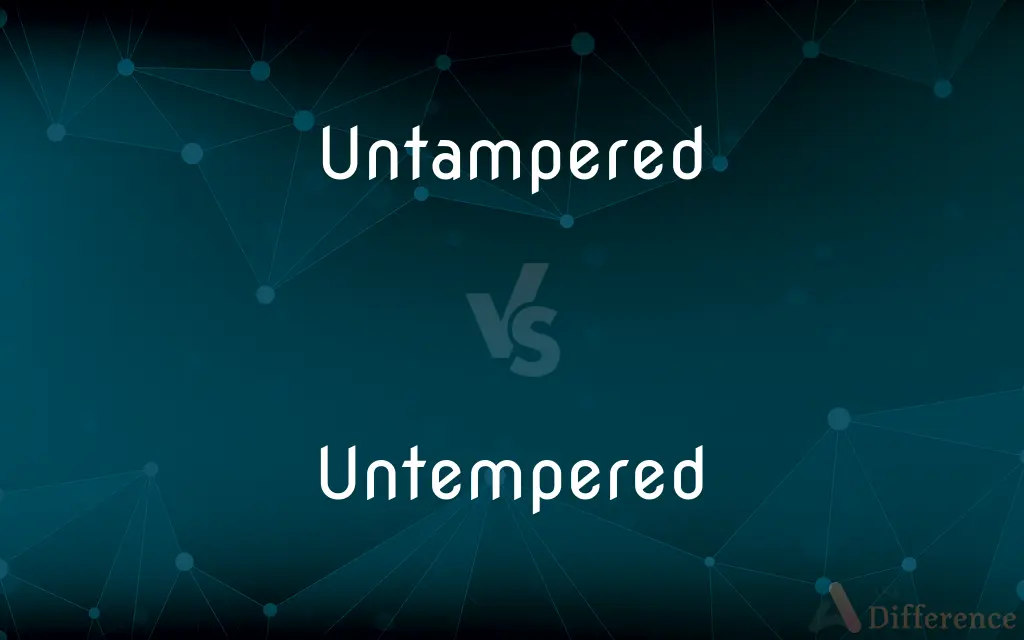Untampered vs. Untempered — What's the Difference?
By Tayyaba Rehman & Fiza Rafique — Updated on April 22, 2024
Untampered refers to something unaltered or untouched, while untempered generally describes material that hasn't been hardened.

Difference Between Untampered and Untempered
Table of Contents
ADVERTISEMENT
Key Differences
Untampered implies that an item, data, or environment remains in its original, unchanged state, reflecting no signs of interference or modification. Whereas untempered is often used to describe materials, especially metals or glass, that have not undergone a process of hardening or tempering to improve strength or resilience.
Untampered evidence or documents are crucial in legal contexts, suggesting they have been preserved without any tampering that could compromise their validity. On the other hand, untempered steel is softer and more malleable compared to tempered steel, which is treated to be tougher and more durable.
Untampered can also refer to a natural setting or ecological system that has been preserved without human impact, maintaining its original biodiversity and geological state. Whereas untempered might describe raw materials or ingredients that have not been processed or altered to enhance properties or performance.
Untampered often carries a positive connotation, especially when referring to purity and authenticity in various contexts, from historical artifacts to scientific data. In contrast, untempered may carry a negative implication in contexts where increased toughness or durability is desired.
Untampered scenarios or products are valued for their genuineness and integrity, essential in fields like forensics and antiquities. Meanwhile, untempered materials may be less desirable in construction and manufacturing due to their lack of enhanced properties typically introduced by tempering.
ADVERTISEMENT
Comparison Chart
Definition
Not altered or interfered with in any way
Not hardened or not treated through tempering
Typical Use
Legal, data security, historical authenticity
Materials science, manufacturing
Connotation
Positive (purity, authenticity)
Neutral or negative (lacking desired properties)
Importance in Context
High in preserving integrity and authenticity
High in achieving material strength and resilience
Example of Usage
Untampered crime scene
Untempered steel
Compare with Definitions
Untampered
Unchanged by external factors.
The ecosystem has remained largely untampered despite nearby urban development.
Untempered
Not hardened by heat treatment.
The blade was made of untempered steel, making it less durable.
Untampered
Not modified or altered.
The document was found to be untampered and valid for use in court.
Untempered
Free from the process of strengthening.
The fabric was untempered, remaining soft and pliable.
Untampered
Free from unauthorized interference.
The data remained untampered, ensuring the accuracy of the research results.
Untempered
Lacking in emotional restraint or maturity.
His untempered response to criticism revealed his inexperience.
Untampered
Maintained in its original condition.
The artifact was kept untampered in the museum display.
Untempered
Not adjusted to achieve desired properties.
The material was left untempered, which affected the final product's quality.
Untampered
Not adjusted or tampered with.
The settings on the device were untampered, as indicated by the seals.
Untempered
Not subjected to tempering.
The glass was untempered and therefore more prone to shattering.
Untampered
Not tampered with.
Untempered
Not tempered; not conditioned by a process.
Untempered
In the case of a person, inexperienced; untested.
Untempered
Not brought to a proper consistency or hardness;
Untempered mortar
Untempered steel
Untempered
Not tempered;
Individualism untempered by social responsibilities
Untempered
Extravagant or extreme;
The inhumanity of his untempered principles
Common Curiosities
Can a document be both untampered and untempered?
No, untampered applies to not being altered, while untempered does not apply to documents as it refers to material properties.
How can one ensure that an artifact remains untampered?
By employing strict security measures and maintaining a controlled environment free from external interference.
What does untampered mean in a legal context?
It refers to evidence that has not been altered or tampered with, preserving its validity.
Why is tempering important for materials?
Tempering processes enhance the strength, toughness, and durability of materials like steel and glass.
What are the consequences of using untempered materials in construction?
Using untempered materials can lead to structural failures due to lack of strength and resilience.
What measures can be taken to ensure data remains untampered?
Regular audits, using encryption, and maintaining secure backups help ensure data remains untampered.
How can the authenticity of an untampered item be verified?
Authenticity can be verified through forensic analysis, provenance documentation, and integrity checks.
Is untempered chocolate the same as untempered steel?
No, in chocolate, untempered refers to chocolate that hasn't been correctly crystallized to ensure shine and snap, unlike untempered steel which lacks hardness.
Can untampered evidence still be questioned in its reliability?
Yes, even untampered evidence can be questioned based on its collection, preservation methods, and the chain of custody.
Are there situations where untempered materials are preferred over tempered ones?
Yes, untempered materials are preferred when the workability of the material is more important than its strength, such as in certain artistic or bespoke crafting applications.
What does it mean when someone describes a reaction as untempered?
It typically means the reaction is spontaneous and uncontrolled, often reflecting raw emotion or lack of moderation.
In what contexts is the term untempered most commonly used?
Untempered is commonly used in the context of materials science, particularly relating to metals and glass that have not undergone a hardening process.
What are the benefits of using untempered materials?
Untempered materials can be beneficial when flexibility and malleability are more important than strength or durability.
What risks are associated with untampered software settings?
Untampered settings might lack necessary updates and patches, potentially exposing the system to security risks.
How can museums ensure their artifacts remain untampered?
Museums can ensure artifacts remain untampered by using security systems, controlled access, and environmental controls.
Share Your Discovery

Previous Comparison
Commentator vs. Journalist
Next Comparison
Electron vs. ProtonAuthor Spotlight
Written by
Tayyaba RehmanTayyaba Rehman is a distinguished writer, currently serving as a primary contributor to askdifference.com. As a researcher in semantics and etymology, Tayyaba's passion for the complexity of languages and their distinctions has found a perfect home on the platform. Tayyaba delves into the intricacies of language, distinguishing between commonly confused words and phrases, thereby providing clarity for readers worldwide.
Co-written by
Fiza RafiqueFiza Rafique is a skilled content writer at AskDifference.com, where she meticulously refines and enhances written pieces. Drawing from her vast editorial expertise, Fiza ensures clarity, accuracy, and precision in every article. Passionate about language, she continually seeks to elevate the quality of content for readers worldwide.
















































